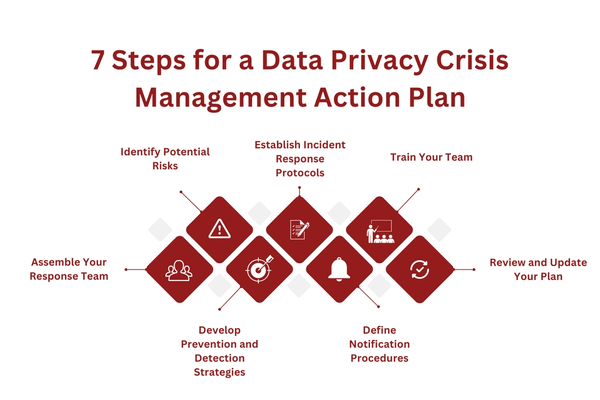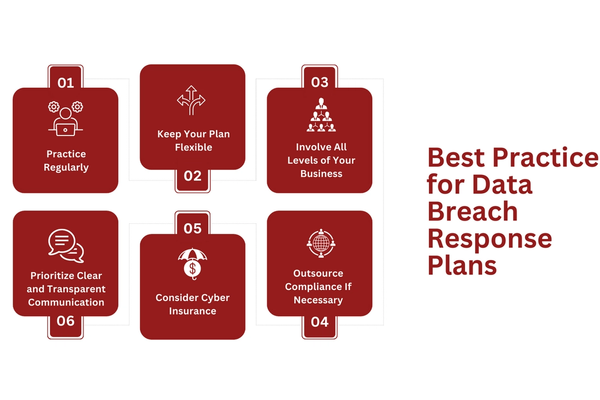
While the digital age offers numerous benefits, it introduces new challenges, notably data privacy. Navigating this new landscape requires a detailed data privacy crisis management action plan (also known as a data breach response plan).
This comprehensive guide will discuss the steps to protect consumers’ data, mitigate potential privacy breaches, and manage any crisis swiftly and efficiently. We aim to provide you with the knowledge and strategies to ensure the highest level of data protection, maintain compliance, and build a trustful relationship with your consumers.
We’ll guide you through developing an action plan that makes data privacy a cornerstone of your business operations.
Key Takeaways
Businesses need a data privacy crisis management action plan to effectively navigate the aftermath of a data breach. It helps them swiftly detect, contain, and respond to a breach, minimizing potential damages and maintaining consumer trust.
Developing a comprehensive action plan involves assembling a response team, identifying potential risks, creating prevention and detection strategies, defining notification procedures, training the team, and regularly reviewing and updating the plan.
Best practices for an effective data breach response plan include regular practice, keeping the plan flexible, involving all levels of the business, considering outsourcing data protection compliance services, procuring cyber insurance, ensuring clear communication, and incorporating lessons learned.
What is a Data Privacy Crisis Management Action Plan?
what is a data privacy crisis-management action plan.png

A data privacy crisis management action plan (or a data breach response plan) is a proactive, structured approach designed to prevent, detect, and respond to incidents that could compromise the security and privacy of personal or confidential data.
This plan is particularly critical for businesses as it can help them navigate the complex aftermath of a data breach while minimizing its potential impacts.
Essentially, this plan outlines the course of action that businesses need to follow when a data breach incident occurs. It includes detection, containment, assessment, notification, and post-incident activities to ensure compliance services and maintain the trust of consumers.
Remember, each business should tailor its data privacy crisis management action plan according to its specific data types, operational context, and regulatory requirements. The data privacy crisis management action plan is also an integral component of a business’s overall cybersecurity strategy, contributing significantly to its corporate compliance.
This action plan is not just about damage control. It is about illustrating a business’s preparedness and dedication to data security, underlining the business’s trustworthiness in handling sensitive data.
Why is a Data Breach Response Plan Important?
why a data breach response plan important.png

The data breach response plan is not just important‒it’s indispensable. With the growing volume and sophistication of cyber threats, the risk of businesses encountering data breaches increases. A robust data breach response plan becomes the shield that safeguards a business and its consumers from the adverse effects of such incidents.
The importance of a data breach response plan is manifold. First and foremost, it helps businesses swiftly detect and contain a breach, significantly minimizing the potential damage. Timely detection is critical as every second counts when a breach occurs.
Delayed detection can lead to increased financial loss and more extensive exposure to sensitive consumer data.
Second, a data breach response plan sets the stage for a coordinated and effective response. In the event of a breach, businesses often have to make high-stakes decisions under immense pressure.
Having a predetermined plan allows them to act decisively and quickly, thus preventing any missteps that could further escalate the crisis.
Third, a data breach response plan is key to maintaining consumer trust. By demonstrating a strong commitment to data privacy and showing preparedness to handle breaches, businesses can reassure their consumers and stakeholders.
This is crucial as a breach can severely damage a business’s reputation and result in the loss of consumer trust.
Lastly, a data breach response plan is often integral to compliance with data protection regulations like GDPR. Non-compliance can lead to hefty fines and further reputational damage.
7 Steps for a Data Privacy Crisis Management Action Plan
7 Steps for a Data Privacy Crisis Management Action Plan.png

Although creating a data privacy crisis management action plan might seem daunting, you can simplify it into strategic steps or utilize various data compliance solutions. The purpose of such a plan is to provide a blueprint for businesses to follow when a data breach occurs.
The plan should be clear, thorough, and tailored to fit the unique context of each business. Here, we provide a step-by-step guide to help businesses develop their data privacy crisis management action plan effectively.
Step 1: Assemble Your Response Team
The first step is to assemble a multi-disciplinary response team responsible for managing the data breach. This team should include individuals from various departments, including IT, legal, PR, and operations. It’s crucial to designate a team leader who will oversee the team’s actions and coordinate the response efforts.
Step 2: Identify Potential Risks
Every business faces unique risks based on the nature of its operations and the type of data it handles. Therefore, it’s crucial to identify and assess potential risks that could lead to data breaches. Regular risk assessments should be conducted to update this information continuously.
Step 3: Develop Prevention and Detection Strategies
With the identified risks, develop prevention and detection strategies. Prevention strategies may include implementing security measures such as firewalls, encryption, and access controls. Detection strategies could involve network monitoring and anomaly detection systems.
Step 4: Establish Incident Response Protocols
Create a protocol for handling detected breaches. This should outline steps for containing the breach, assessing its scope, and initiating recovery measures. Clear communication channels should be established to ensure rapid information dissemination among the team.
Step 5: Define Notification Procedures
Regulations like GDPR require businesses to notify affected consumers and certain authorities about data breaches within specific timeframes. Thus, your plan should include clear procedures for notification, considering both regulatory requirements and your responsibility to your consumers.
Step 6: Train Your Team
Once the plan is developed, train your team to ensure they understand the protocols. Regular drills should be conducted to practice the response procedures and ensure everyone knows their roles when a breach occurs.
Step 7: Review and Update Your Plan
Keep your plan current by regularly reviewing and updating it in line with evolving threats and business changes. Regular audits and tests of the plan will help you identify areas of improvement, keeping your business prepared for potential breaches.
Best Practices for Data Breach Response Plans
Best Practices for Data Breach Response Plans.png

While every data breach response plan is unique to the business it serves, some universally applicable best practices can enhance its effectiveness.
These practices can help businesses ensure that their response plans are not just compliant but also robust and effective in mitigating the potential impacts of a data breach.
Let’s delve into some of the key best practices for data breach response plans.
Practice Regularly
As the saying goes, practice makes perfect. Regularly test and run drills of your plan to ensure its effectiveness and to keep your team well-prepared. This will help identify any gaps or weaknesses that need to be addressed.
Keep Your Plan Flexible
The landscape of cybersecurity threats is constantly evolving. Therefore, your plan must be adaptable. It should be flexible enough to respond to various breach scenarios and should be regularly updated to account for new threats and regulatory changes.
Involve All Levels of Your Business
From top management to entry-level employees, everyone should be aware of the data breach response plan. This is because a data breach can occur at any level, and awareness among all staff can aid in early detection and containment.
Outsource Compliance If Necessary
Sometimes, it can be beneficial to outsource compliance to a privacy consultant or a crisis management business for data privacy help. These professionals can help you create and implement a robust data breach response plan and ensure that you’re in line with all relevant regulations.
Consider Cyber Insurance
Given the potential financial impact of a data breach, consider getting cyber insurance. This can provide a financial safety net in case of a significant breach.
Prioritize Clear and Transparent Communication
In the event of a data breach, clear and transparent communication with stakeholders is crucial. This not only involves communicating with consumers and employees but also possibly with the media, regulators, and shareholders.
Data Privacy Response Plan Checklist
Having a comprehensive checklist is an effective way to ensure that your data privacy response plan covers all bases. The following sections detail the key elements that should be included in your plan, accompanied by specific actions to be taken under each section.
By following this checklist, you can create a robust data privacy response plan that is tailored to your business’s unique needs.
Response Team
Assembling a dedicated response team is an essential first step in your plan. This team is responsible for executing your data breach response plan when a crisis occurs.
Identify and list the members of your response team.
Clearly define the roles and responsibilities of each team member.
Designate a team leader to oversee the response efforts.
Risk Assessment
Conducting regular risk assessments helps in identifying potential vulnerabilities and mitigating them before a breach occurs.
Identify potential risks specific to your business operations.
Evaluate the severity and impact of each risk.
Develop strategies to manage identified risks.
Prevention and Detection
Establish measures to prevent breaches and detect them when they occur.
Implement appropriate security measures (e.g., firewalls, encryption, access controls).
Set up a system for monitoring network traffic and detecting unusual activity.
Regularly update and patch your security systems.
Response Protocols
Your plan should clearly outline the steps to be taken when a breach is detected.
Define steps for containing the breach and limiting its spread.
Detail procedures for assessing the scope and impact of the breach.
Plan recovery measures to restore systems and operations.
Notification Procedures
Complying with legal notification requirements is a critical part of your response plan.
List the authorities and individuals that need to be notified in the event of a breach.
Define a timeline for notifications based on regulatory requirements.
Prepare template communications for different breach scenarios.
Training
Ensure your team is adequately trained to respond to a data breach.
Provide training to your response team on executing the response plan.
Conduct regular drills to test the effectiveness of your plan and team.
Provide cybersecurity awareness training to all staff members.
Review and Update
The last section ensures your plan remains up-to-date in the face of evolving threats and business changes.
Regularly review and update your plan based on changing business needs, regulatory requirements, and the cyber threat landscape.
Incorporate lessons learned from drills and actual incidents.
Audit your response plan regularly to ensure its effectiveness.
Closing
In an era where data breaches are frequent, a comprehensive data privacy crisis management action plan is essential. This plan will safeguard your business and fortify consumer trust, all while ensuring regulatory compliance.
Creating and implementing such a plan can be daunting, but at Captain Compliance, we offer comprehensive compliance solutions. Our team of superheroes can help you formulate a tailored and compliant data breach response plan.
Our team of superheroes can help you formulate a tailored and compliant data breach response plan. We can guide you through implementation, training, regular reviews, and updates in response to evolving threats and regulations.
Are you ready to elevate your data privacy compliance? Reach out to Captain Compliance today. Let’s work together to protect your business and consumers in the digital landscape.
FAQs
What are the regulatory requirements for data breach notification?
Regulatory requirements for data breach notification vary depending on the jurisdiction and the nature of the breached data.
For instance, under GDPR, businesses must report a breach to the relevant supervisory authority within 72 hours of becoming aware of it. Understanding and complying with these requirements is critical to avoid potential legal penalties.
Discover more about regulatory requirements here.
Why should businesses conduct regular risk assessments as part of their data privacy crisis management action plan?
Regular risk assessments allow businesses to identify potential vulnerabilities and threats that could lead to data breaches. By understanding these risks, businesses can implement appropriate prevention and detection strategies, enhancing their overall data security posture.
Explore more about the importance of risk assessments here.
What role does a privacy consultant or a crisis management business play in data privacy crisis management?
Privacy consultants or crisis management businesses can provide expert guidance in creating and implementing a robust data privacy crisis management action plan. They can help ensure that your plan is comprehensive, compliant with regulations, and effective in addressing the unique threats faced by your business.